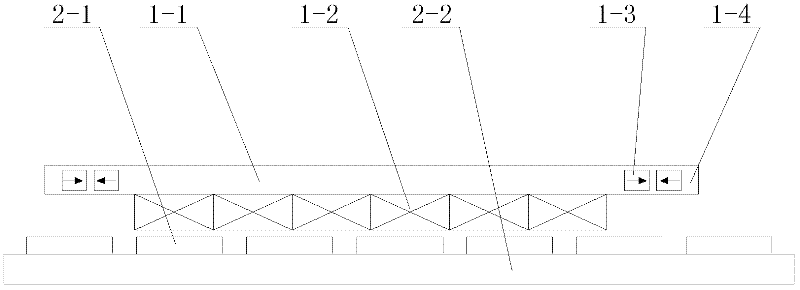Positioning force compensating type linear permanent magnet synchronous motor
A permanent magnet synchronous motor, positioning force technology, applied in the direction of electrical components, electromechanical devices, electric components, etc., can solve the problems of reducing the effective thrust of the motor, increasing the processing cost of the motor, etc., to achieve high motor efficiency, small positioning force, reduced The effect of electromagnetic force fluctuations
- Summary
- Abstract
- Description
- Claims
- Application Information
AI Technical Summary
Problems solved by technology
Method used
Image
Examples
specific Embodiment approach 1
[0042] Specific implementation mode one: the following combination figure 1 Describe this embodiment, the positioning force compensation type linear permanent magnet synchronous motor described in this embodiment includes a primary and a secondary, an air gap between the primary and the secondary, and the primary includes an armature core 1-1 and an armature Winding 1-2, the armature winding 1-2 is a surface mount structure,
[0043] The primary also includes a magnetic isolation permanent magnet 1-3, and the armature iron core 1-1 is embedded with a magnetic isolation permanent magnet 1-3 in the armature iron core 1-1 at both ends of the relative movement direction between the armature core 1-1 and the secondary. The permanent magnet 1-3 runs through the armature core 1-1 in parallel.
[0044] The secondary in this embodiment is composed of a secondary permanent magnet 2-1 and a secondary yoke 2-2. The armature winding 1-2 is pasted and fixed on the air gap side surface of...
specific Embodiment approach 2
[0046] Specific implementation mode two: the following combination Figure 2 to Figure 7Describe this embodiment, the positioning force compensation type linear permanent magnet synchronous motor described in this embodiment includes a primary and a secondary, an air gap between the primary and the secondary, and the primary includes an armature core 1-1 and an armature winding 1-2, the primary is a cogged structure,
[0047] The primary also includes a magnetic isolation permanent magnet 1-3 and a compensation tooth 1-4, and the two ends of the armature core 1-1 along the relative movement direction of the secondary are respectively provided with a compensation tooth 1-4. The yokes at both ends of the 1-1 are embedded with magnetic isolation permanent magnets 1-3, and the magnetic isolation permanent magnets 1-3 run through the yoke of the armature core 1-1 in parallel.
[0048] The secondary in this embodiment is composed of a secondary permanent magnet 2-1 and a secondary ...
specific Embodiment approach 3
[0050] Specific implementation mode three: the following combination Figure 2 to Figure 4 Describe this embodiment, this embodiment is a further description of Embodiment 1 or 2, the magnetic isolation permanent magnet 1-3 at each end of the armature core 1-1 is one or two, and the magnetic isolation permanent magnet 1-3 The magnetization direction of 3 is perpendicular to the moving direction, and the magnetization directions of all magnetic separation permanent magnets 1-3 are the same.
PUM
 Login to View More
Login to View More Abstract
Description
Claims
Application Information
 Login to View More
Login to View More - R&D
- Intellectual Property
- Life Sciences
- Materials
- Tech Scout
- Unparalleled Data Quality
- Higher Quality Content
- 60% Fewer Hallucinations
Browse by: Latest US Patents, China's latest patents, Technical Efficacy Thesaurus, Application Domain, Technology Topic, Popular Technical Reports.
© 2025 PatSnap. All rights reserved.Legal|Privacy policy|Modern Slavery Act Transparency Statement|Sitemap|About US| Contact US: help@patsnap.com



